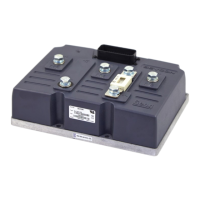VPDO (Virtual Process Data Object)
VPDOs do a similar job as PDOs for data exchange, but internal to a single Sevcon node. They
are unique to Sevcon and are not part of CANopen.
Network Configuration
General
If non-Sevcon nodes need to be added, use the following procedure to setup the network:
1. Set node ID and baudrate in 5900
h
to the required values. Node IDs must be unique,
and the baudrate must be the same for each node.
2. Set SYNC COB-ID in 1005
h
to 0x40000080 for the master node, or to 0x00000080 for all
slave nodes. Bit 30 is set to indicate to a node if it is the SYNC producer. Only one node
in the network should be configured as the SYNC producer. This should normally be the
master. On the SYNC producer, set the SYNC rate in 1006
h.
3. Set the EMCY message COB-ID to 0x80 + node ID in 1014
h
.
WARNING: EMCY COB-IDs must be configured correctly to ensure the master handles
EMCYs from slaves correctly.
4. Configure the heartbeat producer rate in 1017
h
. This is the rate at which this node will
transmit heartbeat messages.
5. Configure the heartbeat consumer rate in 1016
h
. A consumer should be configured for
each node to be monitored.
WARNING: Heartbeats must be configured correctly for correct network error handling.
The master node should monitor heartbeats from all slave nodes. Slave nodes should, at
a minimum, monitor heartbeats from the master node.
6. On standalone systems with non-CANopen nodes attached, hardware CANbus fault
detection should be enabled at 5901
h
. CANbus fault detection is automatically enabled
for multi-node CANopen systems.
7. Configure additional SDO servers. An SDO server allows another CANopen device to
SDO read/write from a node’s object dictionary. Each node has one default SDO server
(1200
h
) which is reserved for communication with configuration tools like DVT or the
calibrator. Another 3 SDO servers can be configured at 1201
h
to 1203
h
. These should be
used as follows:
a. On slave nodes, configure a server to allow the master node to communicate.
b. If there is a display in the system, configure a server to allow the display access.
8. On the master node, configure SDO clients at 1280
h
to 1286
h
. There must be one client
for each slave node. The SDO clients must be configured to match the corresponding
SDO server on each slave.
9. On the master node, list all slave node IDs at 2810
h
.
10. Configure RPDOs (1400
h
to 17FF
h
) and TPDOs (1800
h
to 1BFF
h
) appropriately for the
system. See section, Object mapping (page 6-11), for more information.

